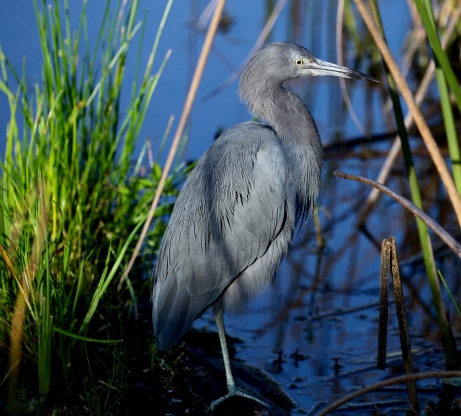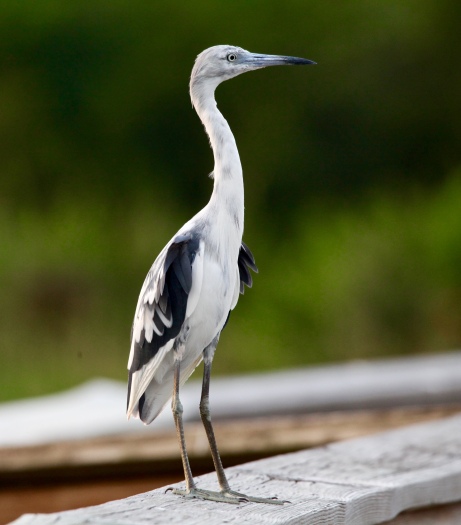An hour before sunset, while everyone was eagerly watching the skies for other more showy birds flying in to roost, I spotted this lovely adult Little Blue Heron hiding in the marsh. How do I know this blue-gray bird is an adult? Because, curiously, Little Blue Herons are completely white when young. The white juvenile Little Blues are often mistaken for other species of white egrets or herons, with whom they forage. Watch this 1-minute video clip to see what I mean – Audubon Moment.
How do I know this blue-gray bird is an adult? Because, curiously, Little Blue Herons are completely white when young. The white juvenile Little Blues are often mistaken for other species of white egrets or herons, with whom they forage. Watch this 1-minute video clip to see what I mean – Audubon Moment.
If you look closely, you can easily distinguish the young, totally white Little Blue Heron from other wading birds by its slow, deliberate movements, greenish legs, and two-toned blue beak. (See more at All About Birds).
As the months pass, the juveniles develop patches of blue, like this fellow below, until they finally molt into their dusky blue and purple adult plumage. Check out a Birder’s Journey post from March 2017 that illustrates this remarkable change in coloring – The little blue wading bird who starts out white.
Check out a Birder’s Journey post from March 2017 that illustrates this remarkable change in coloring – The little blue wading bird who starts out white.

Thanks for this lovely post, BJ.
LikeLiked by 1 person
Thank you for your kind thought and your visit, Jet! Lovely bird, lovely setting – what a joy to see.
LikeLiked by 1 person
Whoa, the first bird captured me!
LikeLike
Glad you liked it, Cindy. He captured me, too, standing there in the waning light, looking quite serene.
LikeLike
Is it known whether being white as a juvenile serves any purpose?
LikeLiked by 1 person
Yes, here, for example is how it’s described in All About Birds:
“Little Blue Herons may gain a survival advantage by wearing white during their first year of life. Immature birds are likelier than their blue elders to be tolerated by Snowy Egrets—and in the egrets’ company, they catch more fish. Mingling in mixed-species flocks of white herons, immature Little Blue Herons probably also acquire extra protection against predators.”
LikeLike
I’m glad I asked. Thanks for the information.
LikeLiked by 1 person
I’m glad you asked, too. The logical conclusion would seem to be they’d stand out, and therefore be more vulnerable to predation, while just the opposite is true.
LikeLike
Fascinating! However, the lil Blue Heron isn’t so small at 29 inch. Thoughts?
Great shot and info, thanks!
LikeLiked by 1 person
Good point! I tried to find something specific about this but couldn’t yet. My guess is that it might just be referred to as the little blue heron to distinguish it from the great blue heron.
LikeLike
We have a white phase little blue at our pond quite often. They are so pretty!
LikeLiked by 1 person
Lucky you! They are quite graceful and deliberate, don’t you think?
I’ve also often seen them described as “stealthy”.
LikeLiked by 1 person
We have a pond with a dock. They like to sit on top one of the posts and survey the area. So pretty!
LikeLiked by 1 person
Wonderful pictures of this little fellow, BJ! I remember when I first saw a juvenile and had no idea what bird it was.
LikeLiked by 1 person
Thank you and thanks for stopping by, Tiny! I think it’s their ‘demeanor’ and foraging behavior that became the real clue for me. ☺️ I need to check your latest posts to see what you are up to since your trip home. I know the Gulf coast has been hit really hard by the red tide this year, but not sure if it reached your area.
LikeLike
Beautiful captures!
LikeLiked by 1 person
Thanks Amy… they’re very special little birds.
LikeLike